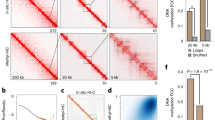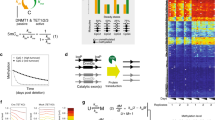Abstract
DNA methylation is an epigenetic mark that is critical in determining chromatin accessibility and regulating gene expression. This epigenetic mechanism has an important role in T-cell function. We used genome-wide methylation profiling to characterize the DNA methylome in primary human CD4+ T cells. We found that only 5% of CpG islands are methylated in CD4+ T cells, and that DNA methylation peak density is increased in subtelomeric chromosomal regions. We also found an inverse relationship between methylation peak density and chromosomal length. Our data indicate that DNA methylation in gene promoter regions is not always a repressive epigenetic mark. Indeed, about 27% of methylated genes are actively expressed in CD4+ T cells. We demonstrate that repressive methylation peaks are located closer to the transcription start site (TSS) compared with functionally non-repressive peaks (−893±110 bp versus −1342±218 bp (mean±s.e.m.), P-value <0.05). We also show that both a larger number and an increased CpG island density in promoter sequences predict transcriptional permissiveness of DNA methylation. TSS in the majority of genes with permissive DNA methylation peaks is in DNase I hypersensitive sites, indicating a failure of DNA methylation to induce chromatin inaccessibility in these loci.
This is a preview of subscription content, access via your institution
Access options
Subscribe to this journal
Receive 6 digital issues and online access to articles
$119.00 per year
only $19.83 per issue
Buy this article
- Purchase on Springer Link
- Instant access to full article PDF
Prices may be subject to local taxes which are calculated during checkout





Similar content being viewed by others
References
Reik W, Dean W, Walter J . Epigenetic reprogramming in mammalian development. Science (New York, NY) 2001; 293: 1089–1093.
Li E, Beard C, Jaenisch R . Role for DNA methylation in genomic imprinting. Nature 1993; 366: 362–365.
Mohandas T, Sparkes RS, Shapiro LJ . Reactivation of an inactive human X chromosome: evidence for X inactivation by DNA methylation. Science (New York, NY) 1981; 211: 393–396.
Bird AP . Functions for DNA methylation in vertebrates. Cold Spring Harb Symp Quant Biol 1993; 58: 281–285.
Hansen RS, Wijmenga C, Luo P, Stanek AM, Canfield TK, Weemaes CM et al. The DNMT3B DNA methyltransferase gene is mutated in the ICF immunodeficiency syndrome. Proc Natl Acad Sci USA 1999; 96: 14412–14417.
Ballestar E, Esteller M . SnapShot: the human DNA methylome in health and disease. Cell 2008; 135: 1144–1144 e1141.
Pan Y, Sawalha AH . Epigenetic regulation and the pathogenesis of systemic lupus erythematosus. Transl Res 2009; 153: 4–10.
Sawalha AH . Epigenetics and T-cell immunity. Autoimmunity 2008; 41: 245–252.
Sawalha AH, Jeffries M, Webb R, Lu Q, Gorelik G, Ray D et al. Defective T-cell ERK signaling induces interferon-regulated gene expression and overexpression of methylation-sensitive genes similar to lupus patients. Genes Immun 2008; 9: 368–378.
Sawalha AH, Jeffries M . Defective DNA methylation and CD70 overexpression in CD4+ T cells in MRL/lpr lupus-prone mice. Eur J Immunol 2007; 37: 1407–1413.
Rauch TA, Wu X, Zhong X, Riggs AD, Pfeifer GP . A human B cell methylome at 100-base pair resolution. Proc Natl Acad Sci USA 2009; 106: 671–678.
Shen L, Kondo Y, Guo Y, Zhang J, Zhang L, Ahmed S et al. Genome-wide profiling of DNA methylation reveals a class of normally methylated CpG island promoters. PLoS Genet 2007; 3: 2023–2036.
Irizarry RA, Ladd-Acosta C, Wen B, Wu Z, Montano C, Onyango P et al. The human colon cancer methylome shows similar hypo- and hypermethylation at conserved tissue-specific CpG island shores. Nat Genet 2009; 41: 178–186.
Lister R, Pelizzola M, Dowen RH, Hawkins RD, Hon G, Tonti-Filippini J et al. Human DNA methylomes at base resolution show widespread epigenomic differences. Nature 2009; 462: 315–322.
Nan X, Ng HH, Johnson CA, Laherty CD, Turner BM, Eisenman RN et al. Transcriptional repression by the methyl-CpG-binding protein MeCP2 involves a histone deacetylase complex. Nature 1998; 393: 386–389.
Jones PL, Veenstra GJ, Wade PA, Vermaak D, Kass SU, Landsberger N et al. Methylated DNA and MeCP2 recruit histone deacetylase to repress transcription. Nat Genet 1998; 19: 187–191.
Bird AP, Wolffe AP . Methylation-induced repression—belts, braces, and chromatin. Cell 1999; 99: 451–454.
Eckhardt F, Lewin J, Cortese R, Rakyan VK, Attwood J, Burger M et al. DNA methylation profiling of human chromosomes 6, 20 and 22. Nat Genet 2006; 38: 1378–1385.
Weber M, Hellmann I, Stadler MB, Ramos L, Paabo S, Rebhan M et al. Distribution, silencing potential and evolutionary impact of promoter DNA methylation in the human genome. Nat Genet 2007; 39: 457–466.
Floess S, Freyer J, Siewert C, Baron U, Olek S, Polansky J et al. Epigenetic control of the foxp3 locus in regulatory T cells. PLoS Biol 2007; 5: e38.
Janson PC, Winerdal ME, Marits P, Thorn M, Ohlsson R, Winqvist O . FOXP3 promoter demethylation reveals the committed Treg population in humans. PLoS One 2008; 3: e1612.
Lewin J, Schmitt AO, Adorjan P, Hildmann T, Piepenbrock C . Quantitative DNA methylation analysis based on four-dye trace data from direct sequencing of PCR amplificates. Bioinformatics 2004; 20: 3005–3012.
Boyle AP, Davis S, Shulha HP, Meltzer P, Margulies EH, Weng Z et al. High-resolution mapping and characterization of open chromatin across the genome. Cell 2008; 132: 311–322.
Acknowledgements
This work was supported by the National Institute of Health Grant number P20-RR015577 from the National Center for Research Resources, Grant number R03AI076729 from the National Institute of Allergy and Infectious Diseases, the Oklahoma Rheumatic Disease Research Core Centers; the Department of Veterans Affairs; the University of Oklahoma Health Sciences Center; the Oklahoma Medical Research Foundation. The authors thank Dr J Donald Capra, MD, for his critical review of this paper.
Author information
Authors and Affiliations
Corresponding author
Ethics declarations
Competing interests
The authors declare no conflict of interest.
Additional information
Supplementary Information accompanies the paper on Genes and Immunity website
Rights and permissions
About this article
Cite this article
Hughes, T., Webb, R., Fei, Y. et al. DNA methylome in human CD4+ T cells identifies transcriptionally repressive and non-repressive methylation peaks. Genes Immun 11, 554–560 (2010). https://doi.org/10.1038/gene.2010.24
Received:
Revised:
Accepted:
Published:
Issue Date:
DOI: https://doi.org/10.1038/gene.2010.24
Keywords
This article is cited by
-
Analyses of methylomes of upland and lowland switchgrass (Panicum virgatum) ecotypes using MeDIP-seq and BS-seq
BMC Genomics (2017)
-
Decreased mRNA expression levels of DNA methyltransferases type 1 and 3A in systemic lupus erythematosus
Rheumatology International (2017)
-
Epigenetics and Bone Remodeling
Current Osteoporosis Reports (2017)
-
Genome-scale profiling reveals a subset of genes regulated by DNA methylation that program somatic T-cell phenotypes in humans
Genes & Immunity (2012)
-
The role of epigenetic variation in the pathogenesis of systemic lupus erythematosus
Arthritis Research & Therapy (2011)



